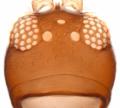Aeolothrips ericae
Recognition data
Distinguishing features
Both sexes with complete, banded wings. Body and legs brown, antennal segment I pale, II–III largely yellow; abdominal segment X much paler than VIII–IX. Head and pronotum with no long setae. Fore tarsus apically with stout recurved ventral hamus. Antennae 9-segmented, segment III with linear sensorium almost 0.5 as long as segment, IV with sensorium more than half length of segment and curved distally; segments V–IX forming a single unit with V considerably longer than VI–IX. Metanotal reticulation weak. Marginal setae on sternites arising at or close to margin; sternite VII supernumerary paired setae arising well in front of margin.
Male tergites IV and V with paired dorsal tubercles; setae at base of claspers on tergite IX shorter than clasper, with stout curved seta lateral to clasper.
Related and similar species
A. ericae is a member of the Eurasian species-complex that includes A. fasciatus, although the males have a pair of very stout setae anterolateral to the bifurcate claspers on the ninth abdominal tergite, as in A. collaris. Just over 90 species are placed currently in the genus Aeolothrips, of which more than 50 are from the Palaearctic Region (mainly Europe), and 28 from the Nearctic (mainly western USA). Only two species are recorded from the Neotropics; the one from Chile is probably the same as A. fasciatus, and one from Panama is probably not a member of this genus (Mound & Marullo, 1996).
Taxonomic data
Current valid name
Aeolothrips ericae Bagnall
Original name and synonyms
- Aeolothrips ericae Bagnall, 1920: 60
- Aeolothrips mulleri Priesner, 1920: 51
- Aeolothrips nobilis Priesner, 1921: 21
- Aeolothrips speciosus Melis, 1933: 169
- Aeolothrips aterrima Hukkinen, 1935: 88
- Aeolothrips albotarsata Keler, 1938: 87
- Aeolothrips lucidus Oettingen, 1944: 40
Family placement
Aeolothripidae
Biological data
Life history
Presumably a facultative predator in flowers, with a mixed diet of pollen and the larvae of other thrips.
Host plants
Usually found on flowering Erica or Calluna (Ericaceae), but also various Fabaceae.
Tospoviruses vectored
None
Crop damage
None
Distribution data
Area of origin
Northern Europe
Distribution
Widespread across western Europe, and introduced to North America. Recorded in California only from two females taken in March 1995 at Casper, Mendocino Co.









